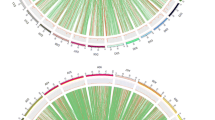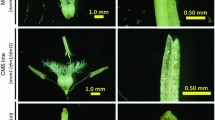Abstract
The recessive ‘tall rice’ phenotype associated with the mutation eui (elongated upper-most internode) is an important agronomic trait that has been introduced into hybrid rice to eliminate panicle enclosure in all types of male-sterile lines and produce good-quality seeds in high yield and at low cost. Based on our previous Eui mapping data, we conducted fine-structure mapping and positional cloning of the gene using an F2 population comprising more than 5000 individuals derived from a cross of the near-isogenic lines 307T ( eui/eui) with the recurrent parent Zhenshan 97 ( Eui/Eui). In total 45 CAPS (cleaved amplified polymorphic sequences) markers located within an interval of 14.5 cM were analyzed in the subpopulation of 1298 homozygous recessive plants. The resulting high-resolution map defined a 98-kb interval containing the Eui locus flanked by the markers M0387 and M01, and three markers were found to co-segregate with Eui. In order to facilitate the identification of the Eui gene, we used a transformation-competent artificial chromosome (TAC) vector to construct a set of contiguous TAC clones from the Nipponbare BACs (obtained from the Clemson University Genome Institute; CUGI) spanning this region. These clones can be used to streamline complementation testing. The markers tightly linked to the Eui locus can also be used in breeding male-sterile lines with the elongated uppermost internode.




Similar content being viewed by others
References
Ashikari M, Wu JZ, Yano M, Sasaki T, Yoshimura A (1999) Rice gibberellin-insensitive dwarf mutant gene Dwarf 1 encodes the α-subunit of GTP-binding protein. Proc Natl Sci USA 96:10284–10289
Goff SA, et al (2002) A draft sequence of the rice genome ( Oryza sativa L. ssp. japonica). Science 296:92–100
He ZH, Shen ZT (1991) Inheritance of panicle exsertion and improvement of male sterile line in rice. Chin J Rice Sci 5:1–6
He ZH, Shen ZT (1994) Sensitivity of elongated internode gene to GA3 and improvement of MS line in rice. Acta Agronomica Sinica 20:161–167
He ZH, Shen ZT, Li DB (1994) Relations of plant height genes to the sensitivity of GA3 and to the regulation of endogenous hormones in different rice growth stages. Plant Physiol Commun 30:170–174
He ZH, ETOH K, Shi CH, Shen ZT (1993) Sensitivity of plant height genes to GA3 and their relationship with enzymes in rice. Chin J Rice Sci 7:143–147
Ikeda A, Ueguchi-Tanaka M, Sonoda Y, Kitano H, Koshioka M, Futsuhara Y, Matsuoka M, Yamaguchi J (2001) slender rice, a constitutive gibberellin response mutant, is caused by a null mutation of the SLR1g ene, an ortholog of the height-regulating gene GAI/RGA/RHT/D8. Plant Cell 13:999–1010
Li X, Qian Q, Fu Z, Wang Y, Xiong G, Zeng D, Wang X, Liu X, Teng S, Hiroshi F, Yuan M, Luo D, Han B, Li J (2003) Control of tillering in rice. Nature 422:618–621
Librojo AL, Khush GS (1986) Chromosomal location of some mutant genes through the use of primary trisomics in rice. In: Khush GS (ed) Rice genetics. IRRI, Manila, pp 249–255
Lincoln S, Daly M, Lander E (1992) Constructing genetic maps with Mapmaker/Exp 3.0 (3rd edn). Whitehead Institute Technical Report, Whitehead Institute, Mass.
Liu YG, Yumiko S, Hidehiro F, Yukihiro Y, Masao T, Tabata S, Shibata D (1999) Complementation of plant mutants with large genomic DNA fragments by a transformation-competent artificial chromosome vector accelerates positional cloning. Proc Natl Acad Sci USA 96:6535–6540
Liu YG, Liu HM, Chen LT, Qiu WH, Zhang QY, Wu H, Yang CY, Su J, Wang ZH, Tian DS, Mei MT (2002) Development of new transformation-competent artificial chromosome vectors and rice genomic libraries for efficient gene cloning. Gene 282:247–255
Maekawa M, Maekawa T, Shinbashi N, Kinoshita T (1989) Allelism of genes for elongation of uppermost internode from two different sources. Rice Genet Newslett 6:101–103
Monna L, Lin X, Kojima S, Sasaki T, Yano M (2002) Genetic dissection of a genomic region for a quantitative trait locus, Hd3, into two loci, Hd3a and Hd3b, controlling heading hnumber =”Sec22”date in rice. Theor Appl Genet 104:772–778
Olszewski N, Sun TP, Gubler F (2002) Gibberellin signaling: biosynthesis, catabolism, and response pathways. Plant Cell 14:S61–80
Peng J, Carol P, Richards DE, King KE, Cowling RJ, Murphy GP, Harberd NP (1997) The Arabidopsis GAI gene defines a signaling pathway that negatively regulates gibberellin responses. Genes Dev 11:3194–3205
Rutger JN, Carnahan HL (1981) A fourth genetic element to facilitate hybrid cereal production. A recessive tall in rice. Crop Sci 21:373–376
Sasaki A, Ashikari M, Ueguchi-Tanake M, Itoh H, Nishimura A, Swapand D, Ishiyama K, Saito T, Kobayashi M, Khush GS, Kitano H, Matsuoka M (2002) Green revolution: a mutant gibberellin-synthesis gene in rice. Nature 416:701–702
Shen ZT, He ZH (1989) Interaction between eui gene and WAMS cytoplasm of rice and improvement of panicle exsertion of MS line. SABRAO J 6:753–756
Shen ZT, Yang CD, He ZH (1987) Studies on eliminating panicle enclosure in WA type MS line of rice Oryza sativa subsp. indica). Chin J Rice Sci 1:95–99
Ueguchi-Tanaka M, Fujisawa Y, Kobayashi M, Ashikari M, Iwasaki Y, Kitano H, Matsuoka M (2000) Rice dwarf mutant d1, which is defective in the α subunit of the heterotrimetric G protein, affects gibberellin signal transduction. Proc Natl Acad Sci USA 97:11638–11643
Virmani SS, Dalmacio RD, Lopez MT (1988) eui gene for elongated uppermost internode transferred to indica rice. Int Rice Res Newslett 13:6
Wu KS, Tanksley SD (1993) PFGE analysis of the rice genome: estimation of fragment sizes, organization of repetitive sequences and relationships between genetic and physical distance. Plant Mol Biol 24:243–254
Wu YL, He ZH, Dong JX, Li DB, Lin HX, Zhuang JY, Lu J, Zheng KL (1998) The RFLP tagging of eui gene in rice. Chin J Rice Sci 12:119–120
Yamanouchi U, Yano M, Lin HX, Ashikari M, Yamada K (2002) A rice spotted leaf gene, Spl7 , encodes a heat stress transcription factor protein. Proc Natl Acad Sci USA 99:7530–7535
Yang RC, Zhang SB, Huang RH, Yang SL, Zhang QQ (2002) Breeding technology of eui hybrids of rice. Scientia Agricultura Sinica 35:233–237
Yang SL, Ma HL, Xue QP, Wang B, Yang RC, Wang B (2001) Genetic and microsatellite analysis of a new elongated uppermost internode gene eui 2 of rice. Acta Botanica Sinica 43:67–71
Yu J, et al (2002) A draft sequence of the rice genome ( Oryza sativa L. ssp. indica). Science 296:79–92
Zhang QQ, Yang RC (2003) The effect of different eui genes on biological characters of e-hybrid rice. Scientia Agricultura Sinica 36:735–739
Zhu XD, Chen HQ, Min SK (2003) Allelism analysis and comparison of plant height, panicle and internode lengths in tall-culm mutants of rice ( Oryza sativa L.). Acta Agronomica Sinica 29:591–594
Acknowledgements
We thank Bin Han for providing the rice BACs and sequence information, Rod Wing for permission to use the BACs, Dabing Zhang, Xudong Zhu and Qingyao Shu for help in growing rice. This work was funded by grants (2001AA222321 and 2002AA2Z1003) from the Ministry of Science and Technology of China and a grant (30270136) from the National Science Foundation of China grant
Author information
Authors and Affiliations
Corresponding author
Additional information
Communicated by R. Hagemann
The first two authors contributed equally to this work
Rights and permissions
About this article
Cite this article
Xu, YH., Zhu, YY., Zhou, HC. et al. Identification of a 98-kb DNA segment containing the rice Eui gene controlling uppermost internode elongation, and construction of a TAC transgene sublibrary. Mol Genet Genomics 272, 149–155 (2004). https://doi.org/10.1007/s00438-004-1019-3
Received:
Accepted:
Published:
Issue Date:
DOI: https://doi.org/10.1007/s00438-004-1019-3




